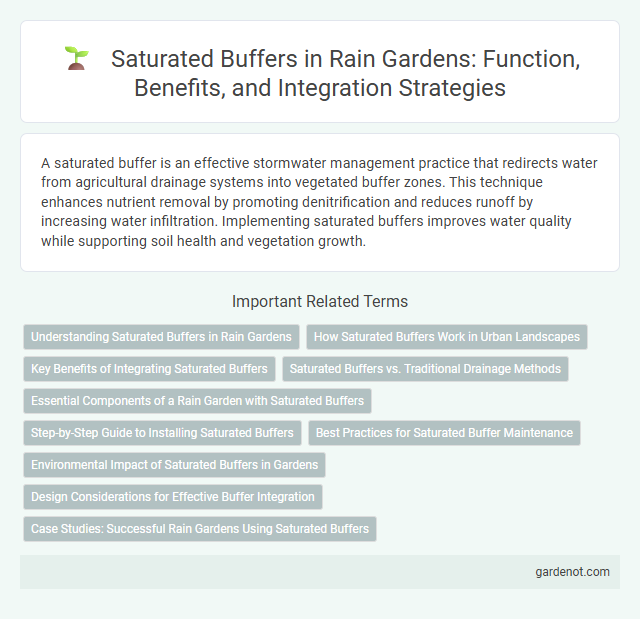A saturated buffer is an effective stormwater management practice that redirects water from agricultural drainage systems into vegetated buffer zones. This technique enhances nutrient removal by promoting denitrification and reduces runoff by increasing water infiltration. Implementing saturated buffers improves water quality while supporting soil health and vegetation growth.
Understanding Saturated Buffers in Rain Gardens
Saturated buffers in rain gardens are designed to intercept and treat agricultural runoff by redirecting water through vegetated buffer zones, enhancing nutrient removal and sediment capture. These systems maintain a saturated soil zone that promotes denitrification, significantly reducing nitrogen concentrations before water enters nearby waterways. Integrating saturated buffers into rain garden designs improves stormwater management, supports groundwater recharge, and protects aquatic ecosystems from nutrient pollution.
How Saturated Buffers Work in Urban Landscapes
Saturated buffers in urban landscapes function by diverting stormwater runoff from impervious surfaces into vegetated buffer zones where water infiltrates the soil slowly, reducing surface runoff and filtering pollutants. These buffers maintain a high water table that supports denitrification and nutrient uptake by native plants, improving water quality before reaching water bodies. Implementing saturated buffers enhances groundwater recharge and mitigates urban flooding while promoting biodiversity within the rain garden system.
Key Benefits of Integrating Saturated Buffers
Saturated buffers enhance rain garden performance by redirecting nutrient-rich runoff into vegetated zones, effectively reducing nitrogen and phosphorus levels before they reach water bodies. These systems improve groundwater recharge and soil moisture retention, promoting healthier plant growth and increasing overall ecosystem resilience. Integrating saturated buffers supports biodiversity by creatingShi microhabitats and mitigating harmful algal blooms through nutrient management.
Saturated Buffers vs. Traditional Drainage Methods
Saturated buffers improve water quality and reduce runoff by redirecting drainage water through vegetated soil zones, enhancing nutrient removal and groundwater recharge. Unlike traditional drainage methods that quickly convey water away, saturated buffers slow flow and promote natural filtration, effectively reducing nitrogen and phosphorus loads before reaching water bodies. This approach supports ecosystem health by maintaining soil moisture and preventing erosion, making it a sustainable alternative to conventional drainage systems.
Essential Components of a Rain Garden with Saturated Buffers
Rain gardens with saturated buffers integrate essential components such as a permeable soil bed, native vegetation, and an engineered subsurface water control system to maximize stormwater infiltration and nutrient removal. Saturated buffers use controlled flow diversion from agricultural or urban drainage systems, allowing water to percolate slowly through the planted buffer zone, enhancing groundwater recharge and reducing nitrate levels. These systems rely on precise soil permeability, proper buffer width, and strategic vegetation selection to optimize pollutant filtration and support sustainable water management.
Step-by-Step Guide to Installing Saturated Buffers
Installing saturated buffers begins with identifying a suitable site adjacent to agricultural fields where tile drainage water can be diverted. Next, a perforated distribution pipe is installed parallel to the buffer edge to evenly disperse water into the soil, followed by backfilling with gravel to enhance infiltration and nutrient removal. Regular monitoring and maintenance ensure optimal performance by preventing clogging and adjusting flow rates to sustain effective saturation and pollutant reduction.
Best Practices for Saturated Buffer Maintenance
Saturated buffer maintenance best practices include regularly inspecting and clearing sediment buildup to ensure consistent water flow through the system, which enhances nutrient filtration and reduces runoff pollution. Maintaining healthy vegetation within the buffer zone is crucial for optimizing water infiltration and stabilizing soil structure. Periodic monitoring of soil moisture and water levels helps identify potential clogging issues, enabling timely corrective actions to sustain optimal system performance.
Environmental Impact of Saturated Buffers in Gardens
Saturated buffers significantly reduce nutrient runoff, particularly nitrogen and phosphorus, by diverting tile drainage water through vegetated filter areas within rain gardens, enhancing groundwater recharge and improving downstream water quality. These systems support diverse plant growth that stabilizes soil and provides habitat for pollinators and wildlife, promoting ecosystem biodiversity. By mitigating pollutant loads and preventing eutrophication, saturated buffers contribute to healthier aquatic environments and sustainable garden landscapes.
Design Considerations for Effective Buffer Integration
Saturated buffers require a design that maintains a stable water table by diverting subsurface flow from agricultural drainage systems into vegetated filter strips, promoting nutrient removal and groundwater recharge. Key considerations include selecting appropriate soil types with moderate permeability, ensuring buffer width accommodates flow rates, and positioning the buffer to optimize hydraulic connectivity between the drainage system and the saturated zone. Proper integration demands assessment of site topography, vegetation selection for pollutant uptake, and monitoring mechanisms to balance saturation levels and prevent surface runoff.
Case Studies: Successful Rain Gardens Using Saturated Buffers
Saturated buffers have proven highly effective in several case studies for improving rain garden performance by enhancing nutrient removal and reducing stormwater runoff. Research from the University of Minnesota demonstrates that saturated buffers can intercept subsurface tile drainage, significantly decreasing nitrate loads before they reach water bodies. These successes highlight saturated buffers as a sustainable technique for optimizing rain garden functions in agricultural and urban landscapes.
Saturated buffer Infographic

 gardenot.com
gardenot.com